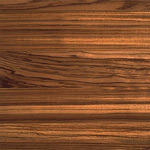For a quicker response, please send all inquiries
via info@canfloor.com or
text to
416-735-0075.
| Monday - Friday | 10:00 am - 7:00 pm |
| Saturday & Sunday | 10:30 am - 4:00 pm |

Scientific Name: Microberlinia brazzavillensis
Other Names and Species: Allen ele, Zebrano, Zingana
Origin: West Central Africa, mainly in Gabon and Cameroon.
Appearance: The sapwood of zebrawood is whitish and distinct from the heartwood, which is pale yellow brown with narrow darker streaks. The striping pattern can vary considerably (hence its name), and that pattern can be maximized by quarter-sawing. Zebrawood may undergo some degree of color change over time, with the light straw-toned background darkening to a richer amber color, and the brown striping turning almost black. This lustrous wood has a texture ranging from medium to coarse, with a grain pattern that is usually wavy or interlocked.
Properties: Zebrawood is considerably harder than red oak, and even northern maple. It is very durable, and highly resistant to termite attack. However, it is an unstable species, particularly in exceptionally dry climates, where it can be prone to shrinkage. This wood should be well-dried and equalized before use.
Workability: The best way to bring out the contrasting striped pattern of zebrawood is to quarter-saw it, which also minimizes the high degree of warping that can occur when the wood is seasoned. This wood saws fairly well; but because machine- and hand-planing tears at the interlocked grain, it may sometimes be difficult to obtain a clean, smooth finish. Veneers need to be carefully handled to avoid cracking. Zebrawood has good gluing properties.
Principal Uses: Zerbrawood is one tough species. For this reason, it makes a great material for wood flooring, and is also used in the manufacturing of skis and tool handles. With its characteristic dark lines or stripes alternating with a lighter, tan-colored background, zebrawood is ideally suited for design accents in decorative veneers and hardwood floors.
